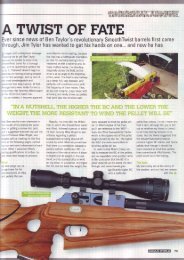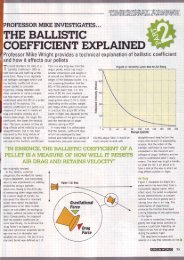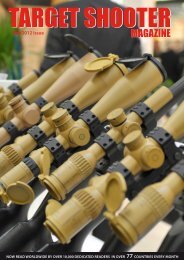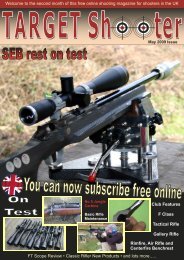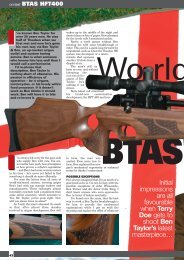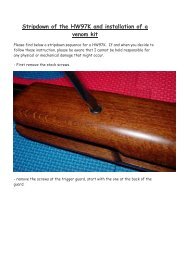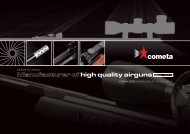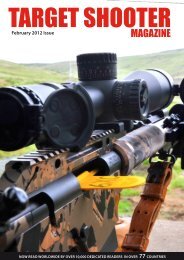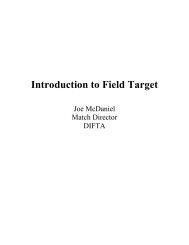Target Shooter 1
Target Shooter 1
Target Shooter 1
You also want an ePaper? Increase the reach of your titles
YUMPU automatically turns print PDFs into web optimized ePapers that Google loves.
Left to right - Berger 155.5, Lapua 155 Scenar, HBC BJD, New Sierra, Berger VLD, PMP,<br />
Bullet i 7<br />
Berger 155.5 Fullbore<br />
Lapua 155 Scenar<br />
155 HBC BJD<br />
(Australia)<br />
Sierra 155 Palma (2156)<br />
Berger 155 VLD<br />
155 PMP (South Africa)<br />
Sierra 155 Palma (2155)<br />
Hornady 155 A-Max<br />
Old Sierra, Hornady A-Max<br />
Average<br />
G7 BC<br />
Retained<br />
Velocity<br />
(1,000yd)<br />
fps<br />
Wind<br />
Deflection<br />
(600yd)<br />
Inches /<br />
MOA<br />
Wind<br />
Deflection<br />
(1,000yd)<br />
Inches / MOA<br />
0.988 0.237 1,302 27.3 / 4.4 91.0 / 8.67<br />
0.988 0.236 1,298 27.4 / 4.4 91.6 / 8.73<br />
0.989 0.236 1,297 27.4 / 4.4 91.6 / 8.73<br />
1.018 0.229 1,257 28.5 / 4.5 95.9 / 9.14<br />
1.039 0.225 1,228 29.2 / 4.6 98.5 / 9.42<br />
1.041 0.224 1,227 29.3 / 4.6 99.2 / 9.45<br />
1.092 0.214 1,161 31.1 / 4.9 106.7 / 10.17<br />
1.100 0.212 1,152 31.4 / 5.0 108.3 / 10.32<br />
Figure 3. Ballistic performance comparison for 8 Fullbore bullets starting out at 3,000<br />
fps MV under standard sea level atmospheric conditions (59°F, 29.53 inches mercury<br />
pressure).<br />
Figure 3<br />
the ‘old’ Sierra Palma MK<br />
(#2155) and the Hornady<br />
A-Max move another 15 to<br />
17 inches sideways in the<br />
wind and struggle to remain<br />
supersonic, close enough<br />
to 1,120 fps to see the<br />
latter have some bullets in<br />
a string risk dropping below<br />
this velocity at the bottom<br />
end of a typical MV spread<br />
allied to slightly more<br />
onerous atmospheric<br />
conditions, such as lower<br />
temperature and/or higher<br />
pressure. Note that<br />
performance variations in<br />
the hypothetical 10mph<br />
crosswind are much<br />
reduced at 600yd, the<br />
difference between the<br />
‘best’ and ‘worst’<br />
equating to just over a<br />
half-MOA compared to<br />
three times that amount<br />
at 1,000yd, so having the<br />
optimal bullet in ballistics<br />
terms confers much less<br />
advantage to the shorterrange<br />
shooter.<br />
So now that we have<br />
these results, how do we<br />
know what to make of<br />
them? The sterile wind<br />
deflection in a constant<br />
10 mph crosswind<br />
performance metric is kind<br />
of useful, but what does<br />
it mean in terms of points<br />
in a match? Is there a<br />
real, practical difference<br />
between say 91” and 95.9”<br />
of wind deflection (the 1st<br />
and 4th bullets respectively<br />
in the list), or is that just lost<br />
in the noise? To attempt to<br />
shed light on this question,<br />
I’ll turn to modelling. The<br />
results of a model are only<br />
as accurate as their inputs.<br />
The bullet performance can<br />
be modelled accurately, but<br />
<strong>Target</strong> <strong>Shooter</strong> 61



